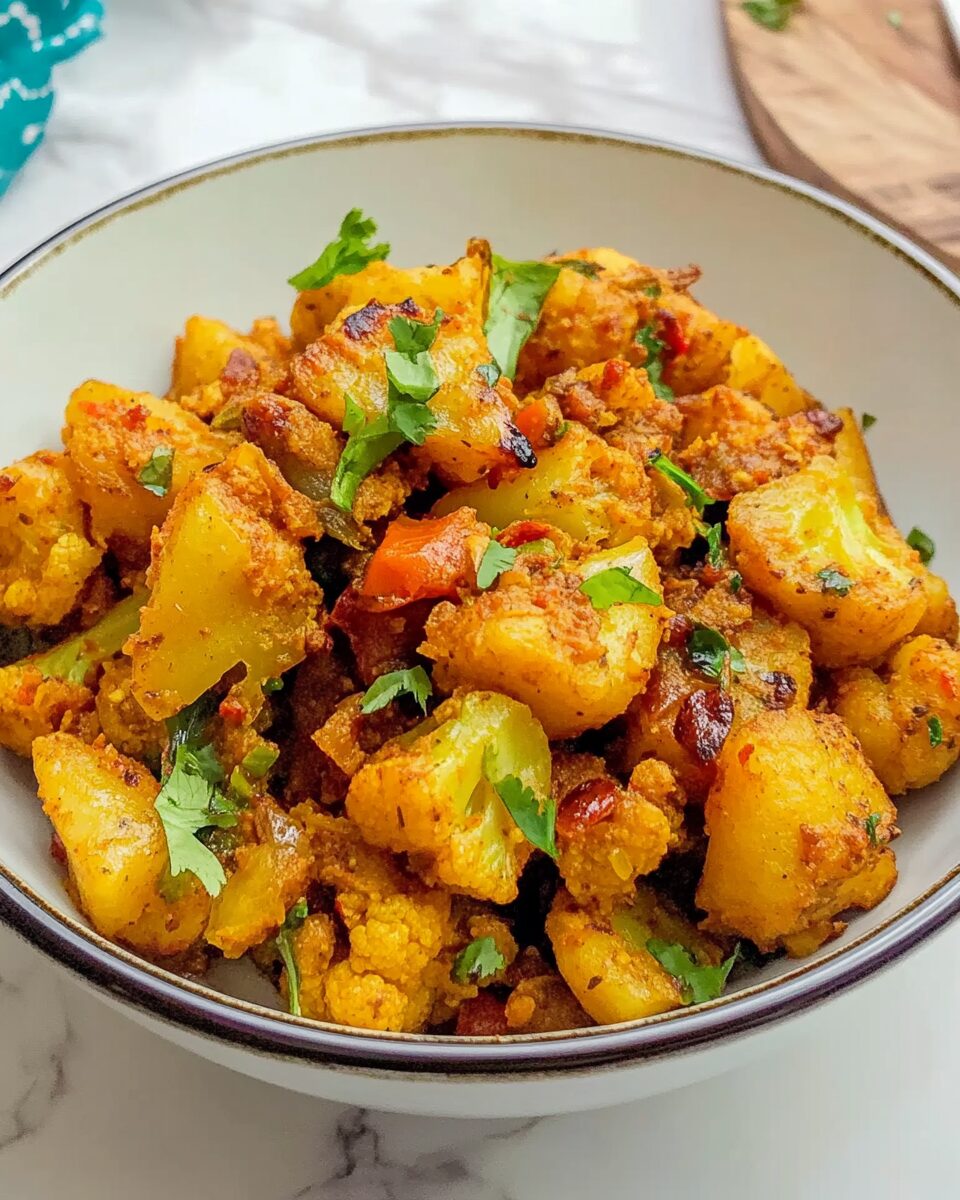Aloo Gobi is a classic North Indian stir-fry featuring tender potatoes and cauliflower florets cooked with aromatic spices, onions, and tomatoes. This vegan and gluten-free dish is a staple in many Indian households and is cherished for its simplicity and delightful flavors. It’s typically enjoyed as a main course or side dish, paired with Indian breads like roti, naan, or parathas.
Full Recipe:
Ingredients
- 1 medium cauliflower, rinsed and cut into medium-sized florets
- 1 cup russet or Yukon gold potatoes, peeled and cut into small cubes
- 2 tablespoons neutral-flavored oil (e.g., avocado or canola oil)
- 1 teaspoon cumin seeds
- 1–2 green chili peppers, slit into two (adjust to taste)
- 1 cup onion, diced (optional)
- 2 teaspoons grated ginger
- 2 teaspoons minced garlic
- 1 cup tomatoes, chopped
- ½ teaspoon turmeric powder
- 2 teaspoons coriander powder
- ½ teaspoon red chili powder (adjust to taste)
- ¾ teaspoon salt (adjust to taste)
- 1 teaspoon garam masala
- 1 teaspoon lime juice
- Fresh cilantro leaves, chopped, for garnishing
Directions
-
Prepare the Vegetables: Rinse the cauliflower and cut it into medium-sized florets. Peel the potatoes and cut them into small cubes.
-
Sauté Aromatics: Heat oil in a heavy-bottomed pan over medium heat. Add cumin seeds and let them sizzle. Add the slit green chili peppers. If using, add the diced onions and sauté until they turn translucent.
-
Add Ginger and Garlic: Stir in the grated ginger and minced garlic. Sauté for about 30 seconds until the raw aroma disappears.
-
Cook Tomatoes and Spices: Add the chopped tomatoes to the pan. Cook until they soften and the oil starts to separate. Stir in turmeric powder, coriander powder, red chili powder, and salt. Mix well.
-
Add Potatoes: Add the potato cubes to the pan. Mix them with the masala and cook for about 5 minutes, stirring occasionally.
-
Incorporate Cauliflower: Add the cauliflower florets to the pan. Stir well to ensure the vegetables are evenly coated with the spice mixture.
-
Cook the Vegetables: Cover the pan and let the vegetables cook on medium-low heat for about 10–15 minutes, stirring occasionally, until the potatoes and cauliflower are tender but not mushy.
-
Finish the Dish: Once the vegetables are cooked, sprinkle garam masala and lime juice over the stir-fry. Mix well.
-
Garnish and Serve: Garnish with freshly chopped cilantro. Serve hot with roti, naan, or parathas.
Nutritional Facts (per serving)
- Calories: Approximately 150 kcal
- Carbohydrates: 25g
- Protein: 5g
- Fat: 5g
- Fiber: 5g
- Sodium: 300mg
Historical Origins
The origins of Aloo Gobi are deeply rooted in the agricultural and cultural history of India. Potatoes were introduced to India by Portuguese traders in the 17th century, while cauliflower made its way to the subcontinent through British influence in the 19th century. The fusion of these two ingredients led to the creation of Aloo Gobi, showcasing the adaptability of Indian cuisine in incorporating new elements into traditional cooking practices. This dish exemplifies how Indian culinary traditions have evolved, blending indigenous flavors with foreign influences to create something uniquely Indian.
Cultural Significance
Aloo Gobi holds a special place in Indian culture, often prepared during family gatherings, festivals, and everyday meals. Its widespread appeal lies in its ability to cater to various dietary preferences, being both vegetarian and adaptable to vegan diets. The dish’s presence in Indian restaurants worldwide has also made it an ambassador of Indian cuisine, introducing international audiences to the rich tapestry of Indian vegetarian dishes. Its simplicity allows it to be a canvas for regional variations, each adding its unique twist while maintaining the core essence of the dish.
Regional Variations
Across India, Aloo Gobi is prepared with regional nuances that reflect local tastes and ingredient availability:
-
Punjabi Style: Known for its robust flavors, the Punjabi version often includes tomatoes and a generous use of spices, resulting in a tangy and spicy profile.
-
Bengali Version: In Bengal, the dish incorporates panch phoron, a blend of five spices, adding a distinctive flavor unique to the region.
-
South Indian Variation: This version may include curry leaves and mustard seeds, infusing the dish with the characteristic flavors of South Indian cuisine.
These variations not only highlight the diversity of Indian culinary practices but also demonstrate the adaptability of Aloo Gobi to different palates and traditions.
Health Benefits and Nutritional Value
Aloo Gobi is not only flavorful but also offers several health benefits:
-
Rich in Vitamins and Minerals: Cauliflower provides vitamins C and K, while potatoes offer vitamin C and potassium, supporting overall health.
-
High in Fiber: Both vegetables contribute dietary fiber, promoting digestive health and aiding in weight management.
-
Low in Calories: When prepared with minimal oil, Aloo Gobi is a low-calorie dish suitable for those monitoring their calorie intake.
A typical serving contains approximately 150 calories, 25 grams of carbohydrates, 5 grams of protein, 5 grams of fat, 5 grams of fiber, and 300 milligrams of sodium, making it a balanced addition to a healthy diet.
Cooking Techniques and Tips
Achieving the perfect Aloo Gobi involves attention to detail and technique:
-
Uniform Cutting: Chop potatoes and cauliflower into similar sizes to ensure even cooking.
-
Spice Tempering: Begin by toasting whole spices like cumin seeds in oil to release their essential oils, enhancing the dish’s aroma and flavor.
-
Avoid Overcooking: Cook the vegetables until tender yet firm to maintain texture and prevent sogginess.
-
Roasting Method: For a modern twist, roasting the potatoes and cauliflower before combining them with the spice mixture can add depth and a subtle smokiness to the dish.
Serving Suggestions
Aloo Gobi pairs well with various accompaniments:
-
Breads: Serve alongside warm roti, naan, or parathas to scoop up the flavorful morsels.
-
Rice Dishes: Complement with steamed basmati rice or jeera rice (cumin-infused rice) for a hearty meal.
-
Condiments: A side of cooling cucumber raita or a tangy mango pickle can enhance the dining experience by adding contrasting flavors.
Conclusion
Aloo Gobi exemplifies the essence of Indian culinary artistry, transforming humble ingredients into a dish that delights the senses and nourishes the body. Aloo Gobi is a beloved vegetarian dish from the Indian subcontinent, featuring a harmonious blend of potatoes (aloo) and cauliflower (gobi) cooked with a medley of aromatic spices. This dish is celebrated for its simplicity, rich flavors, and versatility, making it a staple in Indian households and a favorite among those who appreciate hearty, plant-based cuisine. Its rich history, cultural significance, and health benefits contribute to its enduring popularity both in India and around the world.






